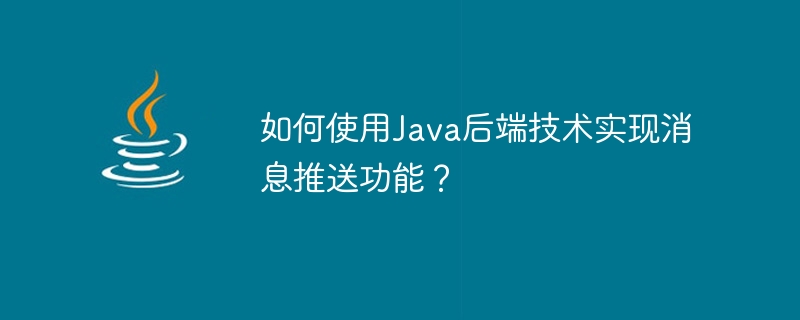

How to use Java backend technology to implement message push function?
With the development of mobile Internet, message push has become an important functional requirement in modern applications. In Java back-end development, we can use some mature technologies and frameworks to implement message push functions. This article will use WebSocket and Spring Boot as examples to introduce how to use Java back-end technology to implement the message push function.
1. Overview
WebSocket is a protocol for full-duplex communication on a single TCP connection. Unlike HTTP, HTTP is stateless, that is, the connection needs to be re-established with each request. The WebSocket protocol establishes a persistent connection between the client and the server, allowing the server to actively push messages to the client.
Spring Boot is a rapid development framework for Java back-end development, which provides rich functions and a good development experience. Combined with WebSocket, we can easily implement the message push function.
2. Use WebSocket to implement message push
First, we need to configure WebSocket support in Spring Boot. In the pom.xml file, add the following dependencies:
<dependency>
<groupId>org.springframework.boot</groupId>
<artifactId>spring-boot-starter-websocket</artifactId>
</dependency>In the Spring Boot configuration class, enable WebSocket support:
@Configuration
@EnableWebSocket
public class WebSocketConfig implements WebSocketConfigurer {
@Override
public void registerWebSocketHandlers(WebSocketHandlerRegistry registry) {
registry.addHandler(new WebSocketHandler(), "/ws").setAllowedOrigins("*");
}
}Next, we need to implement a WebSocketHandler to handle WebSocket messages and connections. Create a class, inherit from TextWebSocketHandler, and override several methods:
@Component
public class WebSocketHandler extends TextWebSocketHandler {
private List<WebSocketSession> sessions = new CopyOnWriteArrayList<>();
@Override
public void afterConnectionEstablished(WebSocketSession session) {
sessions.add(session);
}
@Override
protected void handleTextMessage(WebSocketSession session, TextMessage message) throws Exception {
for (WebSocketSession s : sessions) {
s.sendMessage(message);
}
}
@Override
public void afterConnectionClosed(WebSocketSession session, CloseStatus status) {
sessions.remove(session);
}
}In the above code, we use CopyOnWriteArrayList to save all client connections. After the connection is established, add the WebSocketSession object to the sessions list. When a message arrives, traverse the sessions list and send the message to all clients. When the connection is closed, remove the WebSocketSession object from the sessions list.
Finally, we need to add JavaScript code to the front-end page to establish a connection with WebSocket and process messages. An example is as follows:
var webSocket = new WebSocket("ws://localhost:8080/ws");
webSocket.onopen = function(event) {
console.log("WebSocket连接已建立");
};
webSocket.onmessage = function(event) {
console.log("收到消息:" + event.data);
};
webSocket.onclose = function(event) {
console.log("WebSocket连接已关闭");
};In the above code, we create a WebSocket object and specify the address of the server. Through callback functions such as onopen, onmessage and onclose, we can handle events such as WebSocket connection establishment, message reception and connection closing.
4. Summary
Through the above steps, we successfully implemented the message push function using Java back-end technology. With the help of WebSocket and Spring Boot framework, we can easily implement real-time message push function. In actual applications, we can flexibly use the functions and features of WebSocket and Spring Boot according to needs to achieve more expansion and customization.
The above is the detailed content of How to use Java backend technology to implement message push function?. For more information, please follow other related articles on the PHP Chinese website!
 How to make charts and data analysis charts in PPT
How to make charts and data analysis charts in PPT
 Android voice playback function implementation method
Android voice playback function implementation method
 AC contactor use
AC contactor use
 The difference between vscode and visual studio
The difference between vscode and visual studio
 The difference between Java and Java
The difference between Java and Java
 Introduction to hard disk interface types
Introduction to hard disk interface types
 nagios configuration method
nagios configuration method
 How to delete a folder in linux
How to delete a folder in linux




